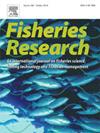Spatial variability of growth improvement based on river use in Japanese seabass
IF 2.3
2区 农林科学
Q2 FISHERIES
引用次数: 0
Abstract
Japanese seabass (Lateolabrax japonicus) exhibits partial migration, wherein some individuals seasonally inhabit estuaries and freshwater environments while others complete their life cycle in marine environments. We hypothesized that seabass exhibit different growth patterns in marine and riverine environments at different geographic locations. To elucidate the commonalities and differences in growth, river use, and their interrelationships across different locations, we investigated seabass growth across marine and riverine environments at three distinct locations in Japan: northern (Miyagi), central (Kyoto), and southern (Oita). Annual growth from ages 0–5 was compared by measuring otolith increment widths, and river use histories were reconstructed from the otolith Sr/Ca ratios. The results indicated that females often rely more heavily on riverine environments than males. Linear mixed models were used to assess the effects of river use and geographic location on the annual growth rates. River use had a positive or neutral effect on growth and riverine growth improvements were lowest in the northern location among our study locations. Additionally, growth rates at ages 0–1 were also lowest in the northern location among the three locations. In contrast, the standard length at older ages was longer at more northern locations. These findings suggest that lower temperatures contribute to slower growth at younger ages, whereas higher temperatures may limit body size at older ages. The distinct characteristics of early growth, growth improvement in rivers, and body size at older ages observed at each geographical location may be responsible for the different growth strategies.
基于河流利用的日本鲈鱼生长改善的空间变异性
日本海鲈(Lateolabrax japonicus)具有部分洄游性,部分个体季节性地栖息在河口和淡水环境中,而其他个体则在海洋环境中完成其生命周期。我们假设在不同的地理位置,海鲈在海洋和河流环境中表现出不同的生长模式。为了阐明不同地区生长、河流利用及其相互关系的共性和差异,我们在日本三个不同的地点调查了海洋和河流环境中的鲈鱼生长:北部(宫城)、中部(京都)和南部(大分)。通过测量耳石增量宽度比较了0 ~ 5岁的年增长率,并通过耳石Sr/Ca比值重建了河流利用历史。结果表明,雌性往往比雄性更依赖于河流环境。采用线性混合模型评估河流利用和地理位置对年增长率的影响。河流利用对生长有积极或中性的影响,在我们的研究地点中,北部地区的河流生长改善程度最低。此外,0-1岁的生长率在三个地点中北部地区也是最低的。相比之下,老年人的标准长度在北部地区更长。这些发现表明,较低的温度会导致幼体发育较慢,而较高的温度可能会限制老年人的体型。在每个地理位置观察到的早期生长、河流生长改善和老年时体型的不同特征可能是不同生长策略的原因。
本文章由计算机程序翻译,如有差异,请以英文原文为准。
求助全文
约1分钟内获得全文
求助全文
来源期刊

Fisheries Research
农林科学-渔业
CiteScore
4.50
自引率
16.70%
发文量
294
审稿时长
15 weeks
期刊介绍:
This journal provides an international forum for the publication of papers in the areas of fisheries science, fishing technology, fisheries management and relevant socio-economics. The scope covers fisheries in salt, brackish and freshwater systems, and all aspects of associated ecology, environmental aspects of fisheries, and economics. Both theoretical and practical papers are acceptable, including laboratory and field experimental studies relevant to fisheries. Papers on the conservation of exploitable living resources are welcome. Review and Viewpoint articles are also published. As the specified areas inevitably impinge on and interrelate with each other, the approach of the journal is multidisciplinary, and authors are encouraged to emphasise the relevance of their own work to that of other disciplines. The journal is intended for fisheries scientists, biological oceanographers, gear technologists, economists, managers, administrators, policy makers and legislators.
 求助内容:
求助内容: 应助结果提醒方式:
应助结果提醒方式:


